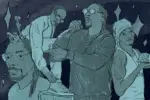You would be hard-pressed to find a millennial who has never heard of “SpongeBob SquarePants,” let alone never watched it religiously. The show has entertained millions throughout the course of its two-decade run.
Even beyond its original format, “SpongeBob” continues to be a part of culture via the internet, where widespread memes based on the show carry on its legacy. Yet after 244 episodes and two theatrical releases, many fans think the cartoon has suffered the same fate as “The Simpsons,” which has similarly overstayed its welcome.
While many adults remember a show that was clever in its comedy, viewers of modern episodes will find that the show has drastically changed. Now, much of the humor has degraded into a juvenile imitation of what it once was. It is almost as if the writers were completely replaced, and the show helmed by people producing what they thought “SpongeBob” was — and that’s precisely what happened.
Steven Hillenberg was a man ensconced in marine biology, beginning his career as an educator at the Orange County Marine Institute. While he would leave this position in 1987, the ocean would remain a deep passion of his as he stepped into the world of animation. Here, he would work on a several comics and a few short animated films before finding his first big success with “Rocko’s Modern Life.” Working as one of the show’s directors would form the foundations for his most famous work.
While a number of sources influenced Hillenberg’s desire to create a cartoon, it was his experience with marine biology that prompted him to generate SpongeBob’s world. Harkening back to his Bob the Sponge character from past comics, the pilot to “SpongeBob SquarePants” aired in 1999, setting off what would become a multi-billion-dollar property. Even in the show’s initial years, merchandise and marketing were everywhere, and with good reason. The show incorporated intelligent writing and, despite parodies often lambasting the cartoon, was more than simply colorful characters making annoying sounds.
Nickelodeon without “SpongeBob” might seem like an alien concept nowadays, but that’s what Hillenberg eventually intended. In 2004, “The SpongeBob SquarePants Movie” hit theaters and was a resounding success both financially and critically. It was also meant to end the show, with Hillenberg and a majority of the staff leaving after the film’s release. Rather than allow “SpongeBob” to end with the grace afforded by the film, Nickelodeon continued with production, turning to remaining staff member Paul Tibbit as the new showrunner.
The years of “SpongeBob” under Tibbit varied in quality, but in general resulted in a very different cartoon. Characters became shallow caricatures of themselves: SpongeBob devolved into a child rather than an adult with childish tendencies, and Patrick’s stupidity shifted from funny to grating. They were deprived of any sort of dimension, given emphasized singular traits, and that is why modern “SpongeBob” is not noteworthy.
Its humor is bland and intermittently marketed with jumping-the-shark gimmicks, disappointing old fans. “SpongeBob” was never a show to shy away from more adult humor, something that old and modern iterations of the series have in common, but, besides irreverent caricatures, what differentiates them is the gore.
Season 6 episode “The Splinter” best exemplifies the new, gory animation. The premise is fairly straightforward: SpongeBob gets a splinter. This idea could have gone a few directions, but the chosen one would leave many viewers disgusted and scratching their heads.
In the episode, an unnecessarily detailed slow-motion sequence plays out where SpongeBob gets the splinter wedged in his thumb. After several failed attempts to remove the object, Patrick’s intervention only makes the wound severely infected, leading to an inflamed, puss-filled mass.
That season produced another gore-filled episode, “House Fancy.” While the plot itself is relatively benign, the horror emerges in a scene where SpongeBob tries to help Squidward move a couch. A couch leg slams on Squidward’s foot, and that’s funny for about the first second before the leg grinds into his suddenly existent toenail, which is slowly and graphically ripped from his foot with pink bits still attached to the nail.
These are just two examples of the countless sight gags common to “SpongeBob,” all incorporating body horror in lieu good writing.
Where “SpongeBob” before 2004 infrequently used visuals like internal organs (the joke having more importance than the visual), the injuries inflicted onto the characters afterward have often been violent, unnecessarily detailed and gratuitous. Even when effort is put into the show, such as its TV movies, the end result never fully captures the original spirit.
Despite this, certain episodes of the most recent seasons have received a degree of positive reception, due in large (if subconscious) part to Hillenberg’s return to the show in 2014. While his return did not fix the show, his influence was enough to help the characters regain some semblance of their past dignity.
In spite of his unfortunate passing, Hillenberg managed to again set his creation on the right path, and it is up to the new showrunners to make of it what they will.
















